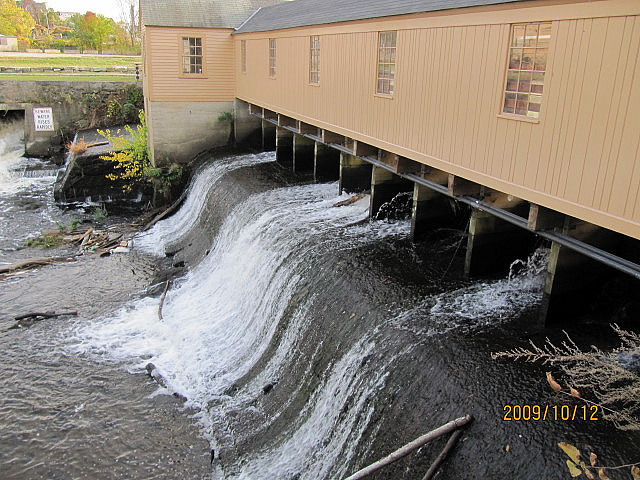Much of the sophisticated system of canals, dams, gates, and tunnels built to manage water power in 19th-century Lowell is preserved today as the basis of the Lowell National Historical Park and the Lowell Heritage State Park. Pictured above is the Boott Penstock, an early channel adjacent to the Boott Mills (right).
The central part of the city of Lowell, Massachusetts-located on the Merrimack River just south of the New Hampshire border - was built almost entirely upon the industrial innovations of the 19th century, relying exclusively on waterpower for textile-mill production. Between 1823 and 1880 in Lowell, the dynamic application of waterpower was developed, studied intensively, and improved upon to an extent unknown anywhere else in the world.
Lowell's nearly six-mile canal system grew gradually, beginning with a shallow transportation canal in 1796 used for power only by a few small textile mills. In 1823, a group of investors began the more ambitious construction of a two-level canal system, which eventually powered more than two dozen large mills. A major building effort in the late 1840s expanded Lowell's available waterpower by another 50 percent, enough to drive 10 major mill complexes. In the 1880s, Lowell's economy began to falter when electricity supplanted waterpower as the preferred power source of American industry.
Facts
- The most sophisticated improvements at Lowell in the application of waterpower are largely attributable to supervising engineer James B. Francis, hired in 1837 at the age of 22. Francis established his reputation with a series of 92 experiments on water flow and turbine efficiency conducted in 1851 and later published in Lowell Hydraulic Experiments, a landmark text.
- The experiments Francis carried out were instrumental in moving the practice of American engineering from a theoretical art toward being an applied science, and the turbine design he developed at Lowell is still in use in hydroelectric plants around the world. In 1881, he served as president of the American Society of Civil Engineers.
- Another contributor of innovations in the use of waterpower at Lowell was Uriah Boyden, an inventor and engineer. Boyden developed a highly efficient water turbine used in many of the Lowell mills beginning in the mid-1840s. He also invented the first hook gauge used to accurately measure water flow, a device patented by Boyden and employed extensively by Francis in his 1851 experiments.
- Much of the sophisticated system of canals, dams, gates, and tunnels built to manage water power in 19th-century Lowell is preserved today as the basis of the Lowell National Historical Park and the Lowell Heritage State Park.
Resources
- Betsy Bahr Peterson, "Industrial Architecture from the Inside: Textile Mill Design and Factory Workplace, 1860-1920," American Historical Review , Vol. 98, No. 3 (Jun., 1993).
- Charles F. Carroll and Pauline A. Carroll, "The Transition from Empirical to Scientific Technology at Lowell, 1839-1859." American Historical Review , Vol. 98, No. 3 (Jun., 1993).
- Edwin T. Layton, Jr., "James B. Francis and the Rise of Scientific Technology"; Technology in America , MIT Press, 1990
- Louis Hunter, Waterpower: A History of Industrial Power in the United States, 1780-1930 ; University Press of Virginia, 1979
- Patrick M. Malone, "Canals and Industry: Engineering in Lowell, 1821-1880." Lowell, MA: Lowell Museum, 1983.
- Robert Wieble, ed., The Continuing Revolution: A History of Lowell, Massachusetts , Lowell, MA: Lowell Historical Society, 1991.



